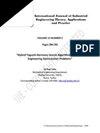机器学习可以最大限度地提高工业过程的效率
IF 1
4区 工程技术
Q4 ENGINEERING, INDUSTRIAL
International Journal of Industrial Engineering-Theory Applications and Practice
Pub Date : 2021-02-25
DOI:10.14445/23499362/IJIE-V8I1P103
引用次数: 0
摘要
-连续的工业制造过程通常由一组连续的控制变量控制。这一过程通常会产生稳定的输出物料,如水泥、食品、牛奶、化学品和糖或发电厂的电力。控制变量可以是电力或化石能源、冷却或加热、润滑、压力等。该过程以给定的输出流量(以吨/天为单位)或以兆瓦为单位进行响应。除以输入功率响应产生一个与过程的效率程度成正比的变量,这在大多数情况下是一个非常重要的参数。为了理解、分析或预测过程,在第一步中,我们将通过光滑函数近似经验响应值,分别使用机器学习技术和多元统计(如张量流或广义线性模型(GLMs))将控制空间映射到区间[0,100%]。两种方法都提供了合适的近似度量。在第二步中,过程将在一组给定的关于控制变量的约束条件下进行优化。由于缺乏过拟合和连续可微性,这一步将仅由glm来说明。这样就可以得到最优设定点和灵敏度系数。本文章由计算机程序翻译,如有差异,请以英文原文为准。
Machine Learning Can Maximize Efficiency in an Industrial Process
- Continuous industrial manufacturing processes are generally controlled by a set of continuous control variables. The process usually produces a steady flow of output material, such as cement, food, milk, chemicals, and sugar or electrical power in a power plant. Control variables may be electrical or fossil power, cooling or heating, lubrication, pressure, etc. The process responds with a given flow of output measured in tons per day or power expressed in Megawatt. Dividing the input power response yields a variable proportional to the degree of efficiency of the process, which is a very important parameter in most cases. To understand, analyze or predict the process, in a first step, we will approximate the empirical response values by a smooth function, mapping the space of controls onto the interval [0,100%], using Machine Learning Techniques and Multivariate Statistics such as Tensor Flow or Generalized Linear Models (GLMs), respectively. Both approaches provide suitable approximation measures. In a second step, the process will be optimized within a given set of constraints concerning the control variables. This step will be illustrated by GLMs only due to their lack of overfitting and their continuous differentiability properties. This way, optimal set points, and sensitivity coefficients will be given.
求助全文
通过发布文献求助,成功后即可免费获取论文全文。
去求助
来源期刊

International Journal of Industrial Engineering-Theory Applications and Practice
Engineering-Industrial and Manufacturing Engineering
CiteScore
1.30
自引率
45.50%
发文量
31
期刊介绍:
The journal emphasizes use of engineering design and analysis and strives to maintain a balance between research and application. The journal covers all aspects of industrial engineering, particularly: Data mining and Computational Intelligence; Production Planning and Control; Operation Research; Service Engineering (Healthcare, etc.); Sustainability (Energy, Environment, etc.); Information Systems and Technology; Management of Technology; Manufacturing; Work Measurement, Human Factors and Ergonomics; Quality, Reliability, Maintenance Engineering; Supply Chain Management; Logistics and Material Handling; Product Design and Development; Statistical Analysis; Modelling and Simulation; Homeland Security (Defense, Disaster Preparedeness, etc.)
 求助内容:
求助内容: 应助结果提醒方式:
应助结果提醒方式:


